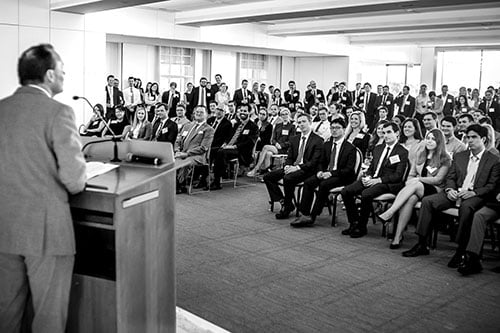Facts of the Case
Provisions of the District of Columbia Code made it illegal to carry an unregistered firearm and prohibited the registration of handguns, though the chief of police could issue one-year licenses for handguns. The Code also contained provisions that required owners of lawfully registered firearms to keep them unloaded and disassembled or bound by a trigger lock or other similar device unless the firearms were located in a place of business or being used for legal recreational activities.
Dick Anthony Heller was a D.C. special police officer who was authorized to carry a handgun while on duty. He applied for a one-year license for a handgun he wished to keep at home, but his application was denied. Heller sued the District of Columbia. He sought an injunction against the enforcement of the relevant parts of the Code and argued that they violated his Second Amendment right to keep a functional firearm in his home without a license. The district court dismissed the complaint. The U.S. Court of Appeals for the District of Columbia Circuit reversed and held that the Second Amendment protects the right to keep firearms in the home for the purpose of self-defense, and the District of Columbia’s requirement that firearms kept in the home be nonfunctional violated that right.
Questions
Do the provisions of the District of Columbia Code that restrict the licensing of handguns and require licensed firearms kept in the home to be kept nonfunctional violate the Second Amendment?
Conclusions
-
The ban on registering handguns and the requirement to keep guns in the home disassembled or nonfunctional with a trigger lock mechanism violate the Second Amendment. Justice Antonin Scalia delivered the opinion for the 5-4 majority. The Court held that the first clause of the Second Amendment that references a “militia” is a prefatory clause that does not limit the operative clause of the Amendment. Additionally, the term “militia” should not be confined to those serving in the military, because at the time the term referred to all able-bodied men who were capable of being called to such service. To read the Amendment as limiting the right to bear arms only to those in a governed military force would be to create exactly the type of state-sponsored force against which the Amendment was meant to protect people. Because the text of the Amendment should be read in the manner that gives greatest effect to the plain meaning it would have had at the time it was written, the operative clause should be read to “guarantee an individual right to possess and carry weapons in case of confrontation.” This reading is also in line with legal writing of the time and subsequent scholarship. Therefore, banning handguns, an entire class of arms that is commonly used for protection purposes, and prohibiting firearms from being kept functional in the home, the area traditionally in need of protection, violates the Second Amendment. In his dissent, Justice John Paul Stevens wrote that the Second Amendment does not create an unlimited right to possess guns for self-defense purposes. Instead, the most natural reading of the the Amendment is that it protects the right to keep and bear arms for certain military purposes but does not curtail the legislature’s power to regulate nonmilitary use and ownership of weapons. Justice Stevens argued that the Amendment states its purpose specifically in relation to state militias and does not address the right to use firearms in self-defense, which is particularly striking in light of similar state provisions from the same time that do so. Justice Stevens also notes that “the people” does not enlarge the protected group beyond the context of service in a state-regulated militia. This reading is in line with legal writing of the time that contextualizes the Amendment in relation to state militias and post-enactment legislative history. Justices David Souter, Ruth Bader Ginsburg, and Stephen G. Breyer joined in the dissent. Justice Breyer also wrote a separate dissent in which he argued that the Second Amendment protects militia-related, not self-defense-related, interests, and it does not provide absolute protection from government intervention in these interests. Historical evidence from the time of ratification indicates that colonial laws regulated the storage and use of firearms in the home. Justice Breyer argued that the Court should adopt an interest-balancing test to determine when the government interests were sufficiently weighty to justify the proposed regulation. In this case, because the interest-balancing turns on the type of analysis that the legislature, not the court, is best positioned to make, the Court should defer to the legislature and uphold the restrictions. Justices Stevens, Souter, and Ginsburg joined in the dissent.
Bruen’s Preliminary Preservation of the Second Amendment
Federalist Society Review, Volume 23
A well regulated Militia, being necessary to the security of a free State, the right...
Banning America's Rifle: An Assault on the Second Amendment?
Federalist Society Review, Volume 22
The AR-15 rifle has aptly been called “America’s Rifle.” It is the most popular rifle...
Wearing, Bearing, or Carrying Arms
In D.C. v. Heller (2008), the Supreme Court recognized an individual right under the...
State Court Docket Watch: State of Wisconsin v. Roundtree
Note from the Editor: The Federalist Society takes no positions on particular legal and public policy...
New Gun Rights Decision: State of Vermont v. Misch
On February 19, the Vermont Supreme Court upheld a state ban on common firearm magazines...
State Court Docket Watch: State of Ohio v. Weber
At 4:00 a.m. on February 17, 2018, Frederick Weber’s wife called the police to report...
McDonald v. City of Chicago, Illinois [SCOTUSbrief]
Short video featuring Joyce Lee Malcolm
When Chicago resident Otis McDonald attempted to purchase a handgun, he was turned down because...
District of Columbia v. Heller [SCOTUSbrief]
Short video featuring Joyce Lee Malcolm
Before 2008, the United States Supreme Court had rarely delved into the meaning of the...
Supreme Silence: A Decade of Second Amendment Litigation in the Circuits
The Federalist Society is pleased to announce its Student Blog Initiative, a project of the...
Second Amendment Historian Stephen Halbrook Demonstrates that Americans Have—and Always Had—a Fundamental Right to Carry Firearms Outside of the Home
Stephen Halbrook’s recent, important paper in the Federalist Society Review, To Bear Arms for Self-Defense:...
To Bear Arms for Self-Defense: A “Right of the People” or a Privilege of the Few? Part 2
Federalist Society Review, Volume 21
Note from the Editor: The Federalist Society takes no positions on particular legal and public...
To Bear Arms for Self-Defense: A “Right of the People” or a Privilege of the Few? Part 1
Federalist Society Review, Volume 21
Note from the Editor: The Federalist Society takes no positions on particular legal and public...
Originalism, Populism, and the Second Amendment’s Right to Keep and Bear Arms
NLC Convention Panel: Special Topic
Less than a month from now, the Supreme Court will hear oral argument in New York...
Stand Your Ground Laws and Retroactivity
State Court Docket Watch
Florida Love v. State Last month, the Florida Supreme Court heard argument...
Second Amendment Returns to Supreme Court in New York State Rifle
The U.S. Supreme Court is taking up a Second Amendment case for oral argument for...
Concealed Carry and the Right to Bear Arms
Federalist Society Review, Volume 20
Note from the Editor: The Federalist Society takes no positions on particular legal and public...
Morrison v. Olson Oral Argument Rewind: Everything Old Is New Again
Historian-turned-politician Sen. Ben Sasse (NE) likes a good historical coincidence. And last week, on April...
The Problem with the Proliferation of Collateral Consequences
Federalist Society Review, Volume 19
Note from the Editor: This article discusses collateral consequences of criminal convictions and argues that...
The Principled Scalia: A Liberal Friend on Scalia’s Liberal Opinions
Federalist Society Review, Volume 18
A Review of: The Unexpected Scalia: A Conservative Justice’s Liberal Opinions, by David M. Dorsen...
Luis v. United States: The Distinction That Makes All the Difference
Federalist Society Review, Volume 18
Note from the Editor: This article discusses the Supreme Court’s 2016 decision in Luis v. United...
D.C. Circuit Strikes Down "Good-Reason" Requirement for Handgun Carry Licenses
After the District of Columbia’s handgun ban was struck down by the Supreme Court in...
Marijuana Use and Firearm Ownership
On November 8th, voters approved recreational marijuana initiatives in California, Massachusetts, Maine, and Nevada, and...
Size Doesn't Matter: Why Shrinking the Supreme Court Won't Promote Constitutionally Limited Government
The Supreme Court needs to be cut down to size. So argues Professor Michael Stokes...
Massachusetts Stun Gun Laws at SCOTUS
On Monday, in Caetano v. Massachusetts, the Supreme Court issued a per curiam opinion vacating...
Written Briefs and the Spoken Word at SCOTUS
Anyone who follows the actual work product of the Supreme Court knows that oral argument...
Book Review: The Right to Try
Engage, Volume 17, Issue 1
Note from the Editor: This book review discusses the controversial concept of the constitutional “right...
An Originalist Future
Engage Volume 15, Issue 1
Note from the Editor: This article discusses the originalist method of constitutional interpretation. As always, The...
Conservative & Libertarian Legal Scholarship: Constitutional Law
V. Constitutional Law
[Return to Table of Contents] V. Constitutional Law Note: The Heritage Foundation has published a...
Illinois Supreme Court Ruling Explores Scope of Second Amendment
State Court Docket Watch Article
On September 12, 2013, in People v. Aguilar, the Illinois Supreme Court held that Illinois’s...
Book Review: Cosmic Constitutional Theory: Why Americans Are Losing Their Inalienable Right to Self-Governance
Engage Volume 14, Issue 2 July 2013
Other Reviews of Cosmic Constitutional Theory: •Marc O. Degirolami, The New Republic, Sept. 2012: http://www.newrepublic.com/book/review/cosmic-constitutional-theory-judicial-restraint...
Mandatory Liability Insurance for Firearm Owners: Design Choices and Second Amendment Limits
Engage Volume 14, Issue 1 February 2013
Some twenty-five years ago, one of us sketched out a rationale for using mandatory liability...
Gunfight: The Battle Over the Right to Bear Arms in America - Faculty Book Podcast
Faculty Division Podcast 07-30-12 featuring Adam Winkler and Nelson Lund
Gunfight: The Battle Over the Right to Bear Arms in America tells the story of the...
Madness, Deinstitutionalization & Murder
Engage Volume 13, Issue 1, March 2012
For those of us who came of age in the 1970s, one of the most...
Does the Fourteenth Amendment Protect Unenumerated Rights?
Engage Volume 12, Issue 2, September 2011
The current debates over the incorporation of the Second Amendment have reignited interest in the...
Constitutional Illusions and Anchoring Truths: The Touchstone of the Natural Law by Hadley Arkes
Engage Volume 11, Issue 3, December 2010
It was her last day of testimony before the Senate Judiciary Committee, and the question...
McDonald v. City of Chicago - Post-Decision SCOTUScast
SCOTUScast 07-02-2010 featuring Steven G. Calabresi
On June 28, 2010, the Supreme Court announced its decision in McDonald v. City of...
McDonald v. Chicago, the Meaning-Application Distinction, and "Of" in the Privileges or Immunities Clause
Engage: Volume 11, Issue 1
In McDonald v. Chicago, the Supreme Court will consider whether the Second Amendment right of...
Anatomy of a Lawsuit: District of Columbia v. Heller
It took nearly 5-1/2 years of litigation, a feckless 32-year handgun ban in the nation’s...
Engage Volume 9, Issue 3, October 2008
Special Issue:Supreme Court Retrospective ADMINISTRATIVE LAW & REGULATION The Supreme Court’s Standing Problem by Ronald...
Bar Watch Bulletin August 2008
Preview of Annual Meeting
Today we offer a preview of the ABA Annual Meeting in New York City. The...
SCOTUScast 6-30-08 featuring C. Kevin Marshall
District of Columbia v. Heller
On June 26, 2008, the Supreme Court decided the District of Columbia v. Heller case. The...
District of Columbia v. Heller
Online Debate
The Court has decided the District of Columbia v. Heller case. The decision, in striking down...
District of Columbia v. Heller
Online Debate
The Court has decided the District of Columbia v. Heller case. The decision, in striking down...
A Round in the Chamber: District of Columbia v. Heller and the Future of the Second Amendment
A new shot will be fired in the development of constitutional law this term when...
Is There Anything "Fundamental" in the Right to Keep and Bear Arms? A Call for Parity in the Incorporation Doctrine
With the District of Columbia v. Heller decision set to arrive sometime in the summer of...
Engage Volume 9, Issue 1, February 2008
ADMINISTRATIVE LAW & REGULATION Climate Change Litigation Since Mass v. EPA by David B. Rivkin,...
Parker v. District of Columbia: DC Gun Ban Case
Online Debate
Earlier this year, the U.S. Court of Appeals for the District of Columbia Circuit ruled...
Public Carry and Judicial Abdication in Defiance of District of Columbia v. Heller
Iowa Student Chapter
Levitt Auditorium, Boyd Law Building130 Byington Road
Iowa City, IA 52246
Public Carry and Judicial Defiance in Abdication of District of Columbia v. Heller
Nebraska Student Chapter
University of Nebraska-Lincoln College of Law1875 N. 42nd St.
Lincoln, NE 68503
Courthouse Steps Decision Teleforum: NY State & Rifle Pistol Association Inc. v. City of New York
Criminal Law & Procedure and Civil Rights Co-Sponsored Practice Group Teleforum
TeleforumThe Second Amendment and the Puerto Rico Weapons Act of 2020
Puerto Rico Lawyers Chapter
Hard Rock Cafe (Second Floor)1214 Ashford Ave.
San Juan, PR 00917








![Click to play: McDonald v. City of Chicago, Illinois [SCOTUSbrief]](https://img.youtube.com/vi/6CZZeXsaFYU/mqdefault.jpg)
![Click to play: District of Columbia v. Heller [SCOTUSbrief]](https://img.youtube.com/vi/2it3XF1fSDY/mqdefault.jpg)





















